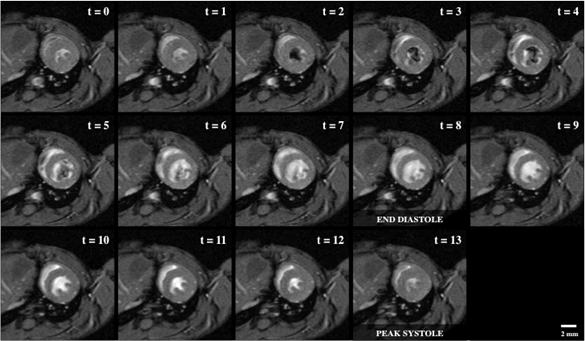Cardiac Magnetic Resonance Imaging
Source: Frederick W. Damen and Craig J. Goergen, Weldon School of Biomedical Engineering, Purdue University, West Lafayette, Indiana
In this video, high field, small-bore magnetic resonance imaging (MRI) with physiological monitoring is demonstrated to acquire gated cine loops of the murine cardiovascular system. This procedure provides a basis for assessing left-ventricular function, visualizing vascular networks, and quantifying motion of organs due to respiration. Comparable small animal cardiovascular imaging modalities include high-frequency ultrasound and micro-computed tomography (CT); however, each modality is associated with trade-offs that should be considered. While ultrasound does provide high spatial and temporal resolution, imaging artifacts are common. For example, dense tissue (i.e., the sternum and ribs) can limit imaging penetration depth, and hyperechoic signal at the interface between gas and liquid (i.e., pleura surrounding the lungs) can blur contrast in nearby tissue. Micro-CT in contrast does not suffer from as many in-plane artifacts, but does have lower temporal resolution and limited soft-tissue contrast. Furthermore, micro-CT uses X-ray radiation and often requires the use of contrast agents to visualize vasculature, both of which are known to cause side effects at high doses including radiation damage and renal injury. Cardiovascular MRI provides a nice compromise between these techniques by negating the need for ionizing radiation and providing the user with the ability to image without contrast agents (although contrast agents are often used for MRI).
This data was acquired with a triggering Fast Low Angle SHot (FLASH) MRI sequence that was gated off of the R-peaks in the cardiac cycle and expiratory plateaus in respiration. These physiological events were monitored through subcutaneous electrodes and a pressure-sensitive pillow that was secured against the abdomen. To ensure the mouse was properly warmed, a rectal temperature probe was inserted and used to control the output of a MRI-safe heating fan. Once the animal was inserted into the bore of the MRI scanner and navigation sequences were run to confirm positioning, the gated FLASH imaging planes were prescribed and data acquired. Overall, high field MRI is a powerful research tool that can provide soft tissue contrast for the study of small animal disease models.
1. Animal Preparation
- Identify the mouse to be imaged in its cage and transfer it to the anesthesia induction chamber.
- Anesthetize the mouse using isoflurane and confirm knockdown using a toe-pinch technique. Take the paw between your thumb and index finger and pinch firmly to check for a response. If the animal withdraws their foot, you should either wait or redose with anesthesia according to the approved protocol.
- Check that all staff entering the imaging facility are MR safe. This incl
Figure 1 shows a cine loop of a short-axis view of the left ventricle, which is directly perpendicular to the base-apex axis of the heart and at a position that includes the papillary muscles.

Figure 1: Bright blood cine imaging of a mouse heart with 14 short-axis view snaps
Here, cardiac MRI is used in conjunction with cardiac- and respiration-gating to acquire cine loop data of the murine heart. While the heart was the focus of demonstration, additional regions of the cardiovascular system can be imaged following the same methodology. Even though MRI does not suffer from the same artifacts commonly seen with other imaging modalities, there is a noticeable trade-off with spatial resolution achieved per acquisition duration. This trade-off is of concern when the mouse cannot withstand longer
Vai a...
Video da questa raccolta:

Now Playing
Cardiac Magnetic Resonance Imaging
Biomedical Engineering
14.6K Visualizzazioni

Imaging di campioni biologici con microscopia ottica e confocale
Biomedical Engineering
35.6K Visualizzazioni

Imaging di campioni biologici con microscopio elettronico a scansione (SEM)
Biomedical Engineering
23.5K Visualizzazioni

Biodistribuzione dei vettori di nanofarmaci: applicazioni del microscopio elettronico a scansione (SEM)
Biomedical Engineering
9.3K Visualizzazioni

Imaging a ultrasuoni ad alta frequenza dell'aorta addominale
Biomedical Engineering
14.4K Visualizzazioni

Mappatura quantitativa della deformazione di un aneurisma dell'aorta addominale
Biomedical Engineering
4.6K Visualizzazioni

Tomografia fotoacustica per l'immagine di sangue e lipidi nell'aorta infrarenale
Biomedical Engineering
5.7K Visualizzazioni

Simulazioni fluidodinamiche computazionali del flusso sanguigno in un aneurisma cerebrale
Biomedical Engineering
11.7K Visualizzazioni

Imaging a fluorescenza nel vicino-infrarosso di aneurismi dell'aorta addominale
Biomedical Engineering
8.2K Visualizzazioni

Tecniche non invasive di misurazione della pressione sanguigna
Biomedical Engineering
11.8K Visualizzazioni

Acquisizione e analisi di un segnale ECG (elettrocardiogramma)
Biomedical Engineering
104.2K Visualizzazioni

Resistenza alla trazione dei biomateriali riassorbibili
Biomedical Engineering
7.5K Visualizzazioni

Imaging micro-CT di un midollo spinale di topo
Biomedical Engineering
7.9K Visualizzazioni

Visualizzazione della degenerazione dell'articolazione del ginocchio dopo lesione del LCA non invasiva nei ratti
Biomedical Engineering
8.2K Visualizzazioni

Imaging combinato SPECT e CT per la visualizzazione della funzionalità cardiaca
Biomedical Engineering
11.0K Visualizzazioni